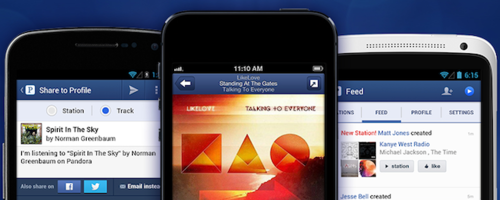
The discussion around whether services like Spotify and Pandora are good for the artist or not seems to come in swells. It picks up for a month or two when a popular artist publicly bashes the model of online music streaming and it gets everyone talking about how bad these services are for the artists. Then the conversations quiets down for a month or two until another artist speaks out against the service model. I have to ask myself, “why does the conversation quiet like that?” It’s because it takes place between the companies and the artists and does not include the listener, the most important person in this whole discussion. The listener is not involved in the conversation because although streaming is becoming their desired form to consume music instead of using other channels, they are able to contribute little directly back. The only reason streaming is succeeding is because it is how listeners are choosing to listen to music. Artists must keep this in mind.

I don’t need to tell you that the Internet has changed everything, but I would like to point out that most companies who refused to build a website and move online in the late nineties and early 2000s do not exist anymore or are light years behind in revenues. The same thing is going to happen to artists who choose to fight the streaming model. If a musician does not have their music on these streaming services, they will most likely not be able to make a living on their music ten years from now. The companies who refused to go online failed because the consumer chose to go online and make purchases instead of frequenting the brick and mortar stores. Its easier and cheaper. When things are easier and cheaper to buy, they can buy more. The cycle is happening again only this time its with music. Its easier and cheaper for them to listen to music through the streaming model. Here’s the great thing about it: the streaming model allows the listener to consume more music than ever before. It makes the discovery process for new music much easier and cheaper. Artists should welcome this model because they can be discovered easier than ever before! The streaming model should be used as a discovery tool and not looked at like a revenue generator.
Musicians have to stop complaining about getting paid pittance from the streaming model. Out of all artists, musicians have it the best and they complain the most. Painters and sculptors do not get paid royalties when someone looks at a picture of their piece online. Musicians have multiple software programs and websites dedicated to helping spread and sell their music. Many musicians believe that these websites take advantage of them and that companies like Spotify make millions of dollars while paying artists almost nothing. The reality is that Spotify and every company like it, including Pandora, have never made a profit since they were created. Even with the pittance payout to artists, they cannot make money. Pandora has spent a lot of time and energy creating a highly targeted advertising platform for companies to use and still continue to be in the red every quarter.
Terrestrial radio broadcasters do not pay performers or the recording copyright owner at all. Yet there hasn’t been an uproar around that model like there has been around the streaming model. This is because historically, more terrestrial radio airplay increased album or single sales. Terrestrial radio was used as a tool by record companies to get attention of their artists and increase sales. The independent artist is in a unique position to use a plethora of tools, including those provided by the streaming model, to attract attention and increase revenue through selling merchandise, tickets or whatever else.
Musicians need a new strategy to make enough money to make a living in the 21st century. In most cases, musicians have never been able to rely on the recording alone to survive and its no different now. Before this strategy is created the streaming model must be looked at with a different point of view which is that the streaming model is the same as the renting model.
How to look at Streaming Model Payments
The streaming model is effectively renting music on-demand. Artists should base their strategies and look at the streaming model in this way. I will admit that the payouts by the streaming model are pittance. I’ve found myself laughing at the $0.005 I make per stream on a good day because it is so little. Many artists get angry at this low payout and simply say that payout should be higher. But, if you look at it from a purely economic standpoint with supply and demand principles, $0.005 seems pretty good considering my song was played among the catalogue of millions of songs recorded in the past century available through the streaming model. Google All Access explains their streaming payouts very economically.

Nigel Godrich
Last week Nigel Godrich said that new music should be separated from the catalogue so new music could get higher payouts when streamed. There are three things wrong with this idea. One, it is not economically sound. Why should new musicians receive special treatment and be coddled away from the supply and demand realities? Two, by stating that new music and catalogue music should be separate Nigel is saying that new music can’t compete with music in the catalogue. Where’s his confidence in the new music? I find it almost insulting. Three, his plan would backfire once popular artists like Rihanna and Darius Rucker are included in the new music higher payout grouping. These artists would get paid even more and independent artists would be in the same position they are now.
Streaming = Renting
This is why the streaming model must be viewed as a renting model. If you try to look at it any other way there are too many problems and it just won’t work. Even if you look at payouts without supply and demand principles the percentage that the artist earns is similar to renting percentages in other industries.
If I was going to rent a backhoe to fix the drainage in my yard I would be able to rent this Kubota at $95 for 4 hours. The original cost of this tractor was $19,089 so I would be renting it for 0.5% of the original price.
When Spotify streams one of my songs that’s worth $0.99 on iTunes for a user, it pays me $0.005. Spotify rents the song from me at 0.5% the original price of the song.
There is nothing wrong with this model. In fact, I believe attacking this model as a whole will result in even lower payments to artists. Pandora has been going to Congress for quite some time now trying to effect lower royalty payments to artists. If artists continue to wage war against the streaming model without an organized plan, Pandora will most likely succeed in lowering payout percentages because they do have a plan. Basically, the focus on attacking the streaming model as whole distracts from the major issue of Pandora wanting to lower payments. I believe that streaming model payments are fine where they are. They should not be lowered. To give Pandora the benefit of the doubt, they are a business with stockholders and they are doing everything they can to make a profit. Pandora and the artist need to find different ways to create revenue.

New Strategies for Musicians
I am confident that musicians will find new and interesting ways to make money in order to support themselves before companies like Pandora figure out how to be profitable. We are more creative and can make decisions faster than companies can. The majority of musicians have never been able to support themselves on record sales alone. They have needed to get creative and offer other products from their recordings. In his autobiography, Ralph Stanley talks about how The Stanley Brothers sold sheet music to their songs at shows to get more money and it became a very popular product at their future shows. Selling sheet music might not be such a new idea now but it was back then, especially for bluegrass music. It has become necessary for an artist to find new and unique ways to support their art, now more than ever before.
Hip Hop artists do an exceptional job in today’s music atmosphere and its because they work extremely hard. They are at work day and night to create new music that they will eventually give away for free on a mixtape, many artists producing a few mixtapes a year. Many of these artists have tons of merchandise for sale that is branded with their logo. Everything from hoodies, to hats, to backpacks and headphones. There’s talk of 2Chainz even releasing a cookbook with his next album. Hip Hop artists work harder than any other genre overall, in my opinion. Artists in other genres should use Hip Hop’s methods and work ethic as an example when building new strategies to promote their music. I’ve learned so much from the genre and I continue to incorporate strategies into my own music promotion (although don’t expect a cookbook from me anytime soon).
There are many ways to succeed in this new on-demand world. There are so many opportunities and artists can easily become overwhelmed by the possibilities. An artist’s time should be spent on how they can work hard to succeed with these new models. Time should not be spent on complaining about the streaming model’s payouts. It is not constructive especially when there are no legitimate alternative plans to accompany complaints.
Conclusion
If listeners want to consume their music in a new, easier and cheaper way the artist can’t fight that. If he or she does, the audience they capture will be significantly lower. My opinion is and always has been that the streaming model is great for the listener and a simple tool on the belt for the musician. If any one tool at musicians disposal is used too often or is relied too highly upon they will not succeed. There is too much focus around the streaming model. Use it as a tool, take the small pay from them and focus energy elsewhere to make revenue.

